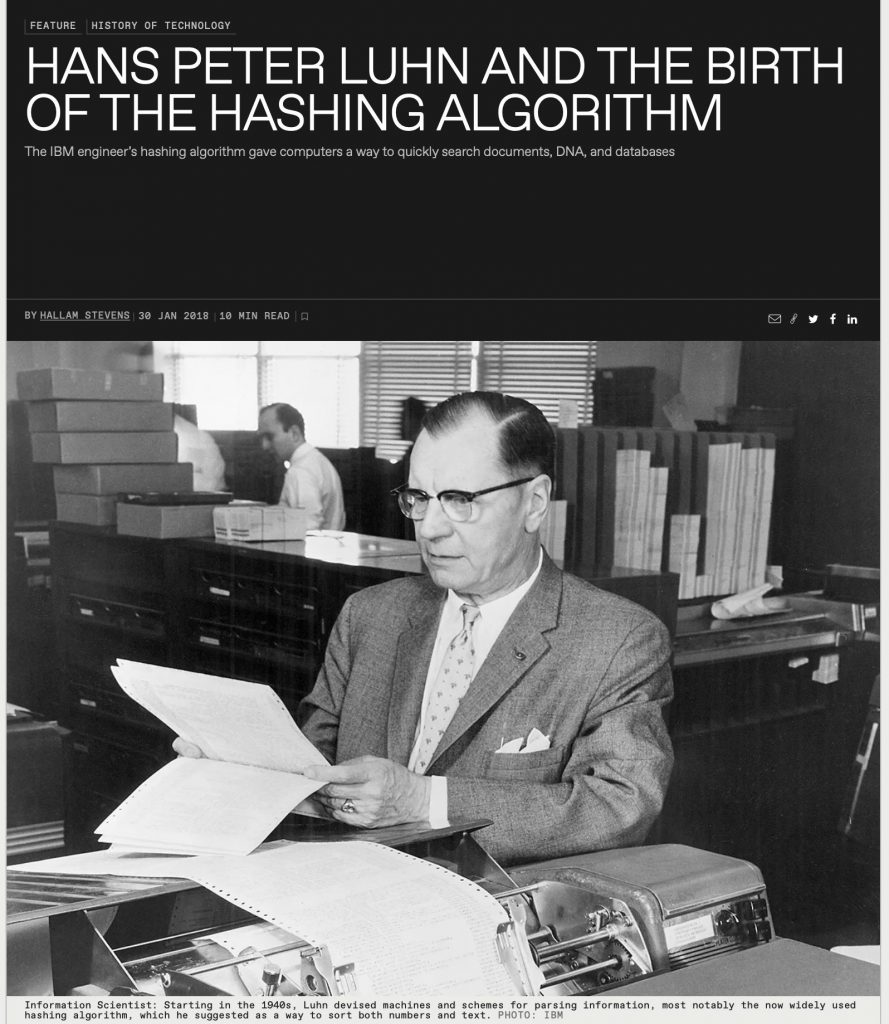Researcher in computing and Science Library & Information for IBM. His inventions can be found in various fields such as computer science, textile industry, linguistics and information science. He is credited with more than 80 patents… Let’s meet Hans Peter Luhn.
Born in Germany in July 1896, he moved to Switzerland after graduating in order to learn the printing trade. His career was interrupted during World War I when he served as a communications officer in the German army. After the war, he joined the textile industry and moved to the USA, where he invented a thread-counting gauge, still in use today: the Lunometer. For 20 years, he was an independent engineering consultant and was granted numerous patents for various inventions. In 1941, he joined IBM (International Business Machine), a large computer manufacturer, as a senior research engineer. He soon became director of the information seeking research division.
In 1947, he was asked to work on a task involving the search for chemical compounds recorded in encoded form. He submitted a punched card approach, but in order to overcome the machine’s limitations, he suggested new ways of using them. Each card is encoded with information about a specific compound. The user inserts a card into the machine and lists a set of criteria against which all cards can be compared and sorted.

Luhn has increasingly devoted his time to solving the information retrieval and storage issues faced by libraries and documentation centres. He pioneered the use of computer hardware to solve these problems, and worked on a number of basic techniques that are now commonplace in the information sciences. These techniques include full-text transformation, KWIC index, auto-indexing, automatic summaries and the concept of Selective Dissemination of Information (SDI). Beyond all these inventions, Hans Peter Luhn was one of those involved in the creation of the hash function.
In the 1958 paper, A Business Intelligence System, Luhn suggested a system to automatically generate summaries of articles, extract action points from those and then dispatch the outcomes to appropriate people within an organisation. This abstract program works by counting all the word frequency in an article. It then pinpoints sentences in which several of the most frequent words are used together. These sentences are then considered to be representative of the whole content and therefore included in the summary. This is a purely statistical method that does not seek to understand neither the words nor the relationships between them. With this approach, Luhn shows how computers can be used to good effect in organising texts and summarising them in formats that are more easily understandable to human beings.
Hans Peter Luhn retired in 1961 and died in 1964 from leukaemia. Despite the fact that his name has now been forgotten, his ideas live on. His way of thinking, groundbreaking at the time, leaves a legacy of demonstrating that computers and calculus are not only about mathematics, statistics and logic. It is also about linguistics and literature. His thoughts, transformed, developed and remixed for various purposes, are now embedded in almost all the softwares being used today.
Translated by par N.PIQUERO.
Nicolas Piquero is a seasoned SEO with 6 years experience. He worked as an in-house, agency and freelance SEO, with various major european companies. Being both a yourtext.guru and babbar.tech power user, it was obvious that he could be an ambassador for babbar’s tools. So, being based in London, he is the first babbar ambassador for the UK.

